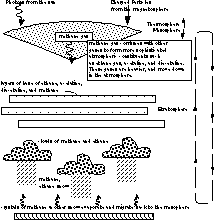This is a diagram of diffusion in the Uranian atmosphere.
Click on image for full size
Diffusion in Uranus Atmosphere
Uranus' atmosphere is made of methane, a medium sized molecule. At the uppermost reaches of the atmosphere, methane gas breaks apart due to energy from the sun and from the magnetosphere. The remins of this methane combine with other gases to form complicated large molecules such as ethane gas, and acetylene. These gases are heavier, and so drop down in the atmosphere.
In regions of the atmosphere where the temperature is cooler, these gases form droplets of haze and smog. At even lower altitudes clouds of methane, ethane, and acetylene form.
At the bottom of the atmosphere, where the temperature warms up and changes to the Uranian interior, the molecules evaporate and break apart again into the methane and the other parts which made it in the first place. These smaller molecules return to the top of the atmosphere by diffusion.
This constant breakdown and assembly of methane and ethane is part of the evolution of Uranus and affects its weather.
You might also be interested in:
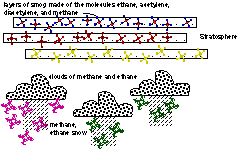
Besides methane, Uranus' atmosphere contains even more complex molecules such as ethane gas. (These gases are similar to the exhaust gases that come out of cars on earth). These molecules form layers of
...more
The methane clouds of Uranus are found low in the atmosphere. The methane clouds are the only clouds to be found on Uranus, but there are hazes of smog high in the atmosphere. The diagram shows that the
...more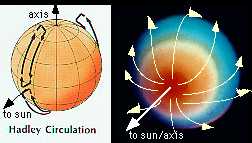
The weather on earth can be described this way: air rises at the equator, where it is warm, and moves to the poles where it is colder and the air sinks. Because Uranus lies on its side, with the north
...more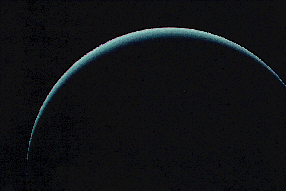
The mesosphere of Uranus is a region of balance between warming and cooling. That essentially means that nothing happens there. Except for diffusion, the atmosphere is still. Upper reaches of the atmosphere,
...more
As on Earth, the atmosphere of Uranus consists of a troposphere, stratosphere, mesosphere, and thermosphere. The troposphere is the region where the visible clouds are to be found. The stratosphere, as
...more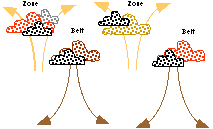
On Uranus, as on Jupiter, the winds in the belts and zones blow first in one direction, then in the opposite direction. Wind blows east in a belt, and west in a zone. The clouds rise up in a belt, and
...more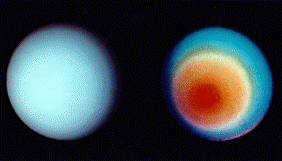
The clouds on Uranus, like Jupiter, are divided into belts and zones. On Uranus the belts and zones are hard to find. The left picture shows the north pole of Uranus. In this picture only the smog of
...more


